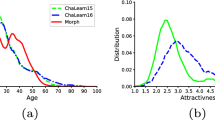Abstract
One of the biggest challenges in the problem of facial attractiveness prediction is the lack of reliable labeled training data. It is very hard to apply a well defined concept to describe the attractiveness of a face. In fact, facial attractiveness prediction is a label ambiguity problem. In order to solve the problem, we propose a novel deep architecture called Deep Adaptive Label Distribution Learning (DALDL). Different from previous works, we use discrete label distribution of possible ratings rather than single label to supervise the learning process of facial attractiveness prediction, and update the label distribution automatically during training process. Our approach provides a better description for facial attractiveness, and experiments have shown that DALDL achieves better or comparable results than the state-of-the-art methods.
Access this chapter
Tax calculation will be finalised at checkout
Purchases are for personal use only
Similar content being viewed by others
References
Baudouin, J.Y., Tiberghien, G.: Symmetry, averageness, and feature size in the facial attractiveness of women. Acta Psychologica 117(3), 313–332 (2004)
Komori, M., Kawamura, S., Ishihara, S.: Effect of averageness and sexual dimorphism on the judgment of facial attractiveness. Vis. Res. 49(8), 862–869 (2009)
Rubenstein, A.J., Kalakanis, L., Langlois, J.H.: Infant preferences for attractive faces: a cognitive explanation. Dev. Psychol. 35(3), 848 (1999)
Eisenthal, Y., Dror, G.: Learning facial attractiveness (2007)
Whitehill, J., Movellan, J.R.: Personalized facial attractiveness prediction. In: IEEE International Conference on Automatic Face and Gesture Recognition, pp. 1–7 (2008)
Gray, D., Yu, K., Xu, W., Gong, Y.: Predicting facial beauty without landmarks. In: European Conference on Computer Vision, pp. 434–447 (2010)
Wang, S., Shao, M., Fu, Y.: Attractive or not?: beauty prediction with attractiveness-aware encoders and robust late fusion, pp. 805–808 (2014)
Gan, J., Li, L., Zhai, Y., Liu, Y.: Deep self-taught learning for facial beauty prediction. Neurocomputing 144(1), 295–303 (2014)
Wang, M., Deng, W.: Deep face recognition: a survey. CoRR abs/1804.06655 (2018)
Li, S., Deng, W.: Deep facial expression recognition: a survey. CoRR abs/1804.08348 (2018)
Xie, D., Liang, L., Jin, L., Xu, J., Li, M.: SCUT-FBP: a benchmark dataset for facial beauty perception 9(6), e98879 (2015)
Ren, Y., Geng, X.: Sense beauty by label distribution learning. In: Twenty-Sixth International Joint Conference on Artificial Intelligence, pp. 2648–2654 (2017)
Fan, Y.Y., et al.: Label distribution-based facial attractiveness computation by deep residual learning. IEEE Trans. Multimedia 20(8), 2196–2208 (2016)
Liang, L., Lin, L., Jin, L., Xie, D., Li, M.: SCUT-FBP5500: a diverse benchmark dataset for multi-paradigm facial beauty prediction (2018)
Liu, Z., Luo, P., Wang, X., Tang, X.: Deep learning face attributes in the wild (2014)
Simonyan, K., Zisserman, A.: Very deep convolutional networks for large-scale image recognition. Computer Science (2014)
Zhang, N., Paluri, M., Ranzato, M., Darrell, T., Bourdev, L.: PANDA: pose aligned networks for deep attribute modeling (2014)
Hui, D., et al.: A deep cascade network for unaligned face attribute classification (2017)
Acknowledgments
This work was partially supported by the National Natural Science Foundation of China under Grant Nos. 61871052 and 61573068.
Author information
Authors and Affiliations
Corresponding author
Editor information
Editors and Affiliations
Rights and permissions
Copyright information
© 2019 Springer Nature Switzerland AG
About this paper
Cite this paper
Chen, L., Deng, W. (2019). Facial Attractiveness Prediction by Deep Adaptive Label Distribution Learning. In: Sun, Z., He, R., Feng, J., Shan, S., Guo, Z. (eds) Biometric Recognition. CCBR 2019. Lecture Notes in Computer Science(), vol 11818. Springer, Cham. https://doi.org/10.1007/978-3-030-31456-9_22
Download citation
DOI: https://doi.org/10.1007/978-3-030-31456-9_22
Published:
Publisher Name: Springer, Cham
Print ISBN: 978-3-030-31455-2
Online ISBN: 978-3-030-31456-9
eBook Packages: Computer ScienceComputer Science (R0)




